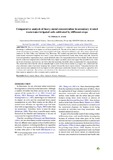Comparative analysis of heavy metal concentration in secondary treated wastewater irrigated soils cultivated by different crops
Date
2010-03Author
Dikinya, O.
Areola, O.
Publisher
Springer, http://link.springer.com/Rights
Available on open access at Springer LinkRights holder
First published by SpringerType
Published ArticleMetadata
Show full item recordAbstract
The use of treated urban wastewater for irrigation is a relatively recent innovation in Botswana and
knowledge is still limited on its impact on soil heavy metal levels. The aim of this study is to analyze and compare heavy
metal concentration in secondary wastewater irrigated soils being cultivated to different crops: olive, maize, spinach and
tomato in the Glen Valley near Gaborone City, Botswana. The studied crop plots have been cultivated continuously
under treated wastewater irrigation for at least 3 years. Most crop farms have sandy loam, loamy sand soils. Based on
food and agriculture organization, heavy metal threshold values for crop production have been studied. Results showed
that the wastewater irrigated soils in the Glen Valley have higher cadmium, nickel and copper than desirable levels, while the levels of mercury, lead and zinc are lower than the maximum threshold values recommended for crop production.
The control sites show that the soils are naturally high in some of these heavy metals (e.g copper, zinc, nickel) and that
crop cultivation under wastewater irrigation has actually lowered the heavy metal content. Comparing between the
crops, mercury and cadmium levels are highest in soils under maize and decline linearly from maize to spinach to olive
to tomato and control site. By contrast, concentrations of the other metals are at their lowest in maize and then increase from maize to spinach to olive to tomato and to control site.

